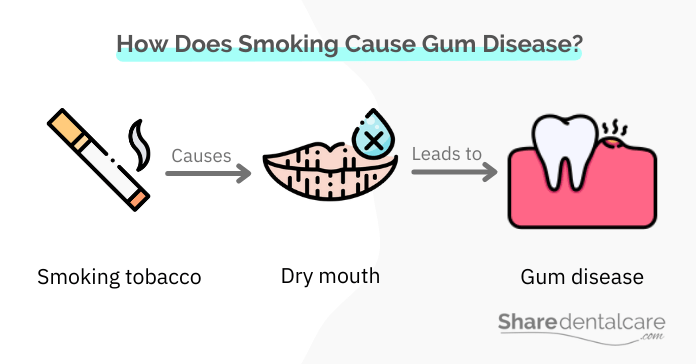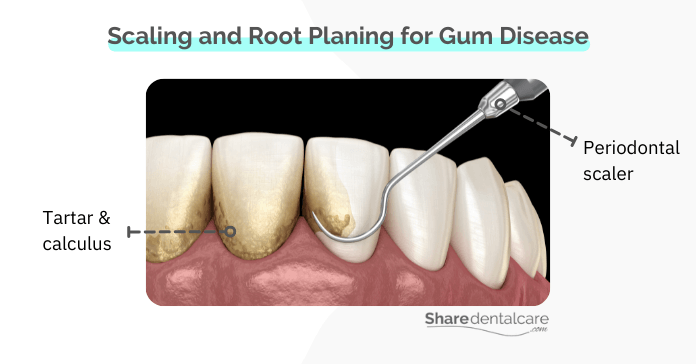Smoking can have a devastating impact on oral health. Smokers have twice the risk for gum disease than nonsmokers, and they’re also at risk for cavities, tooth loss, and other dental problems. Smoking tobacco can also cause black gums, which can make your smile unattractive and affect your self-esteem. In this blog post, we’ll discuss how smoking affects oral health and gums, and smokers’ gums treatment.
What Happens to Smokers Gums & When to Seek Treatment?
Smoking is a dangerous habit that can lead to several health problems, including heart disease and lung cancer. In addition to these health risks, smoking can damage your teeth and negatively affect your gums by causing black gums and gum disease. So, smokers should be aware of these risks and seek treatment for these gums problems to avoid losing their teeth.
Gum Disease
Gum disease, also known as periodontal disease, is a bacterial infection that affects the gums and is a common problem among smokers. This condition is caused by the build-up of plaque and tartar on the teeth. Dental plaque is a sticky film that contains bacteria, which multiply in the presence of sugars and starches from food. Bacteria break down foods and produce toxins that irritate the gums, causing them to become inflamed.
The early stage of gum disease is gingivitis, which causes the gums to become red, swollen, and easily bleed. As gum disease progresses, the infection may spread to the tooth-supporting tissues, causing periodontitis. This may lead to the loosening and loss of teeth, which is why smokers should seek treatment for their gums before gum disease becomes worse.
Smoking is one of the most common risk factors for gum disease. Smokers have twice the risk for gum disease and a lower success rate in gums treatment than non-smokers. Smoking tobacco increases the risk of gum disease because:
- It drys out the mouth. Saliva plays an important role in protecting the mouth from bacteria. It washes away food and neutralizes acids produced by bacteria.
- It reduces the blood circulation in the gums, making it harder for your gums to heal. Blood brings oxygen and nutrients needed for the body to heal.
- Smoking weakens your body’s immune system, making it harder to fight gum infections.

Smoker’s Melanosis
Smokers’ melanosis is a condition that causes the gum tissues to turn brown or black. It is not a serious condition, but smokers’ melanosis can make your smile less attractive and affect your self-esteem. This condition is caused by the accumulation of tar in the gum tissues, which can make them look dark or black.
Smokers’ melanosis is more common in smokers who are heavy smokers and those who have been smoking for many years. So, smokers should be aware of the bad effects of smoking on their gums and seek treatment for smokers’ melanosis. you can read more about dark gums from smoking.
Smokers Gums Treatment Options
The treatment of infected gums in smokers depends on the stage of gum disease.
Non-Surgical Treatment
If you have gingivitis, your dentist will recommend professional teeth cleaning and improving your oral hygiene practices, such as brushing and flossing your teeth daily.
If you have periodontitis, your dentist may recommend a deep cleaning called scaling and root planing. This procedure involves removing the plaque and tartar from below the gum line and smoothing the roots of the teeth to help prevent further infection.

Surgical Treatment
In severe cases, smokers may need surgical treatment to remove the damaged tissue and restore the health of the gums. This surgical treatment may include flap surgery, pocket reduction surgery, and gum graft. You can read more about surgical treatment and reversing periodontal disease bone loss.
Gum Bleaching
In the case of black gums (smokers’ melanosis), the treatment includes quitting smoking and gum bleaching. The gum tissues will turn back to their normal gradually after quitting smoking. If it doesn’t improve, your dentist may recommend a gum bleaching treatment. You can read more about black gums from smoking treatment.
Gums Treatment is Less Effective in Heavy Smokers
Smokers have difficulty recovering from gums infections and less successful outcomes from treatment. This is because smokers have a lower blood flow in their gums, making it more difficult for the gums to heal, which lowers the treatment success rate. Smoking also weakens your body’s immune system, making it harder for your body to fight infection. You can read more about the effect of smoking after oral surgery.
Treatment of Gums Problems in Smokers Can Prevent Health Problems
Both smoking and gum disease are linked to serious health problems. Smoking can increase your risk of having heart disease, cancer, and other health problems. Gum diseases are also linked to serious health problems such as heart disease and stroke. Therefore, smokers who have gums problems should identify it as a warning sign to begin treatment and prevent further health problems.
Tips for Smokers to Keep Their Gums Healthy
There are many ways smokers can protect their gums. If you are a smoker, you should:
- Quit smoking. If you can’t quit smoking, you should at least cut down on the number of cigarettes you smoke per day.
- Brush your teeth at least twice a day.
- Floss daily to remove the food particles and plaque from between your teeth.
- Use fluoride toothpaste to help reduce the bacteria in your mouth.
- Chew sugar-free gum to stimulate the salivary flow and reduce bacteria.
- Drink plenty of water to keep your mouth moist and help remove the toxins from your body.
- Avoid eating foods high in sugar, which can increase the risk of developing gum disease.
- Visit your dentist regularly for professional cleanings and oral exams. Your dentist can detect and treat gum disease early before it becomes more serious.
Smokers Gums Treatment – Conclusion
Smokers should be aware of the health risks of smoking and make quitting a priority. They have an increased risk of developing gum disease, which can cause tooth loss and is linked to serious health problems. Also, smokers have difficulty recovering from gums infections and have less successful outcomes from treatment.
The treatment of gum disease depends on its severity, which includes professional teeth cleaning, scaling, root planing, or surgery in severe cases. Quitting smoking can help smokers recover from gum disease, smokers’ melanosis, and protect their gums from further damage.
If you are a smoker, there are many ways to protect your gums, including brushing and flossing your teeth daily, drinking plenty of water to keep your mouth moist, and visiting your dentist regularly for professional teeth cleaning.